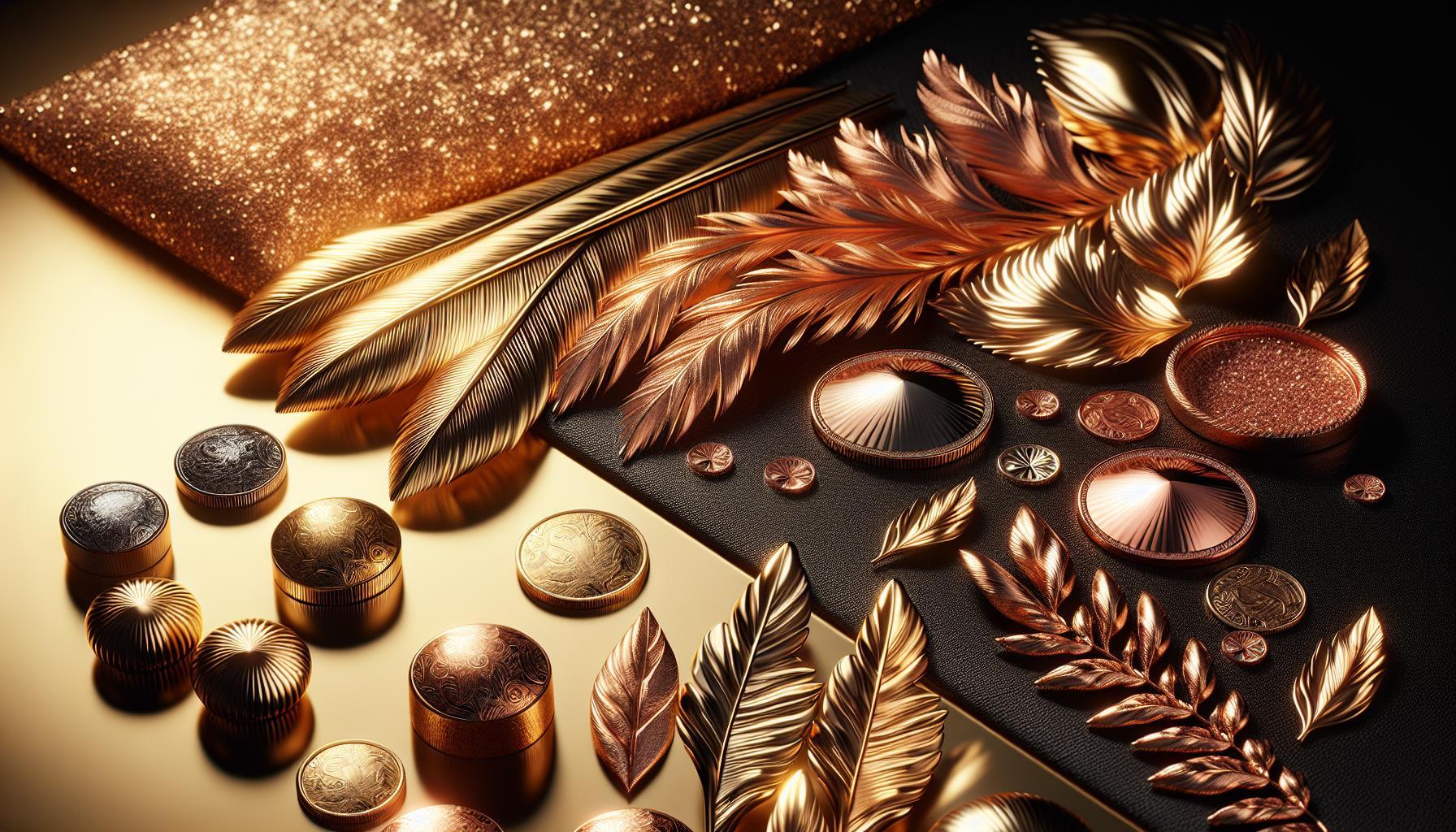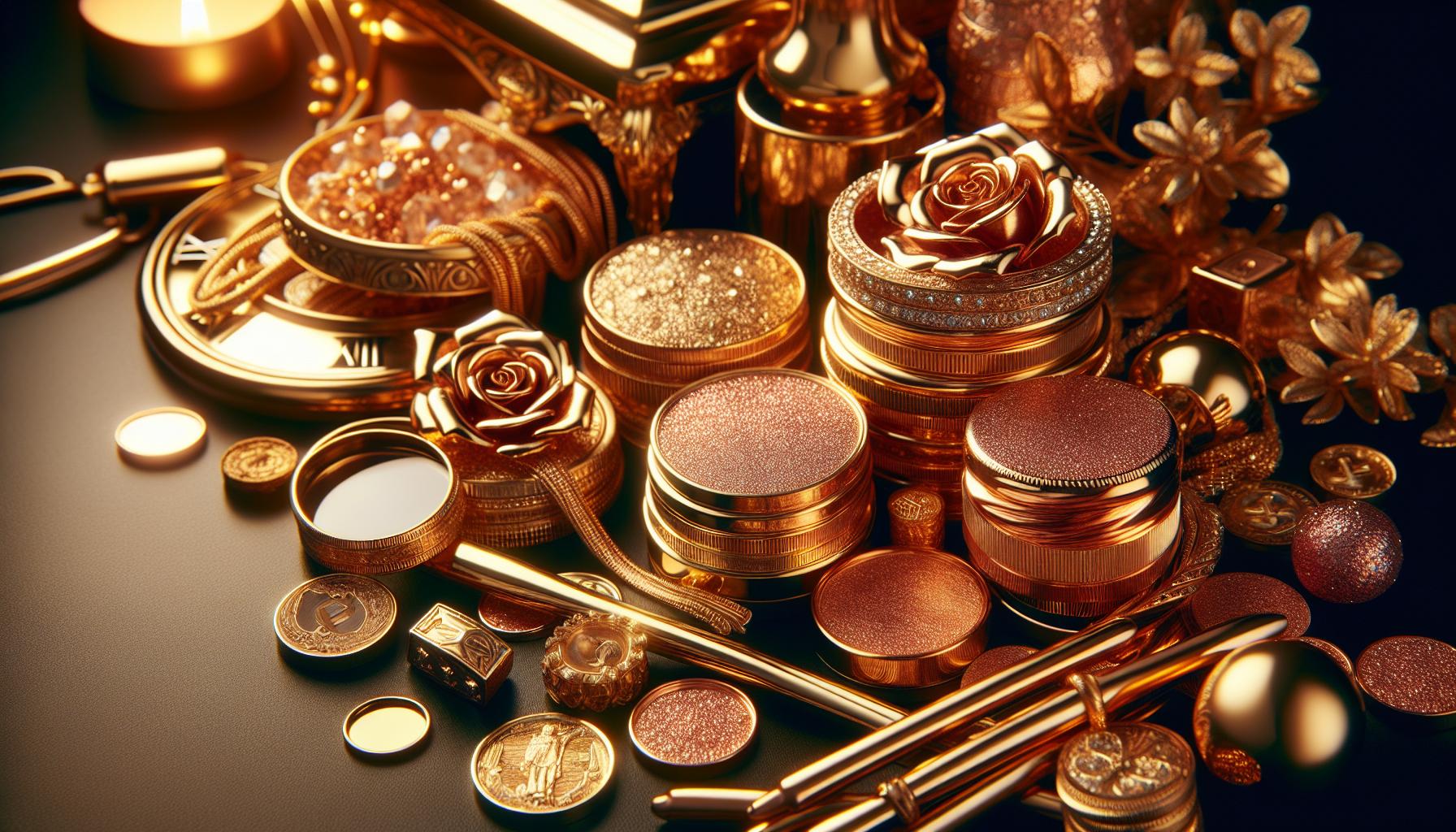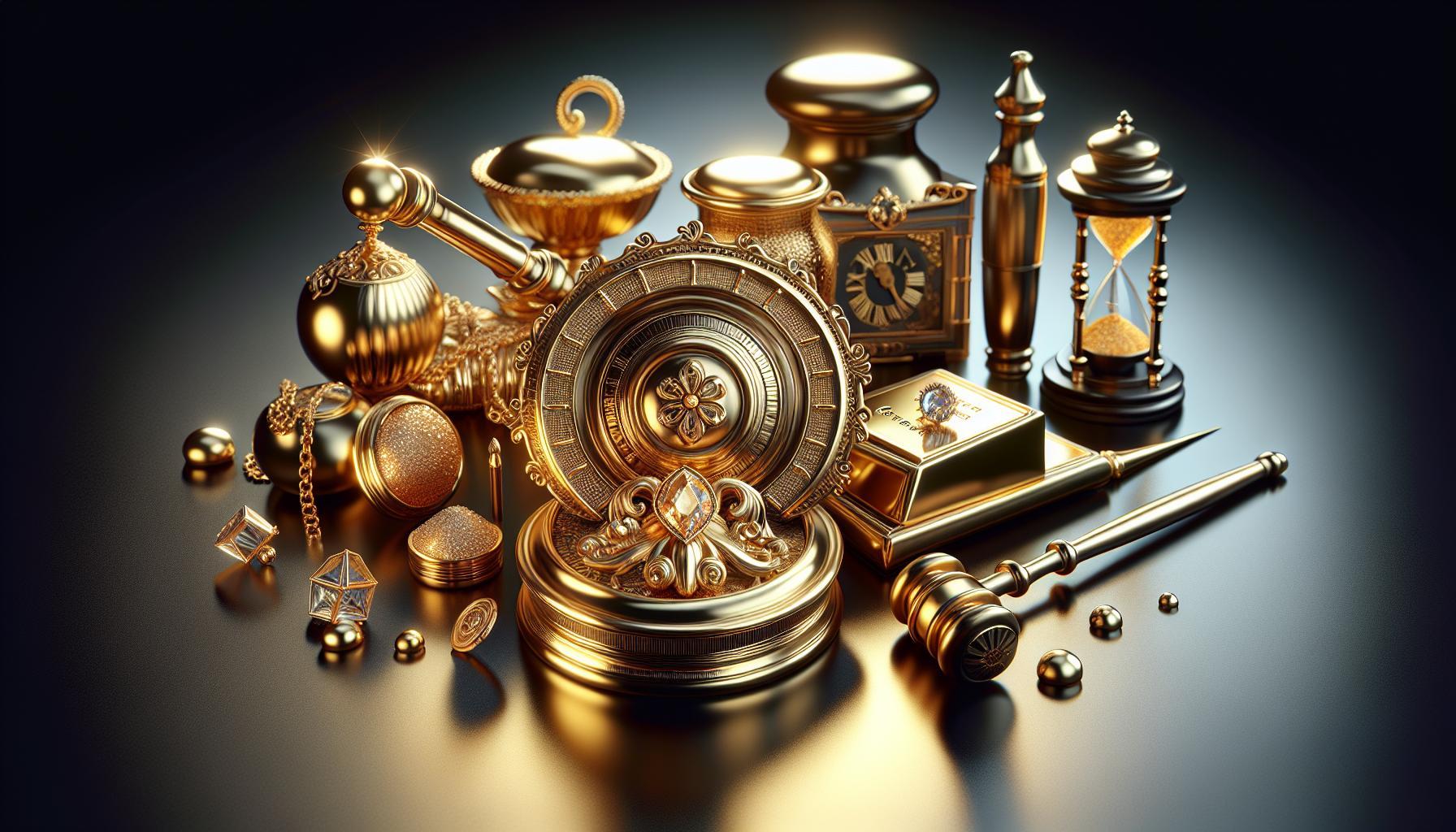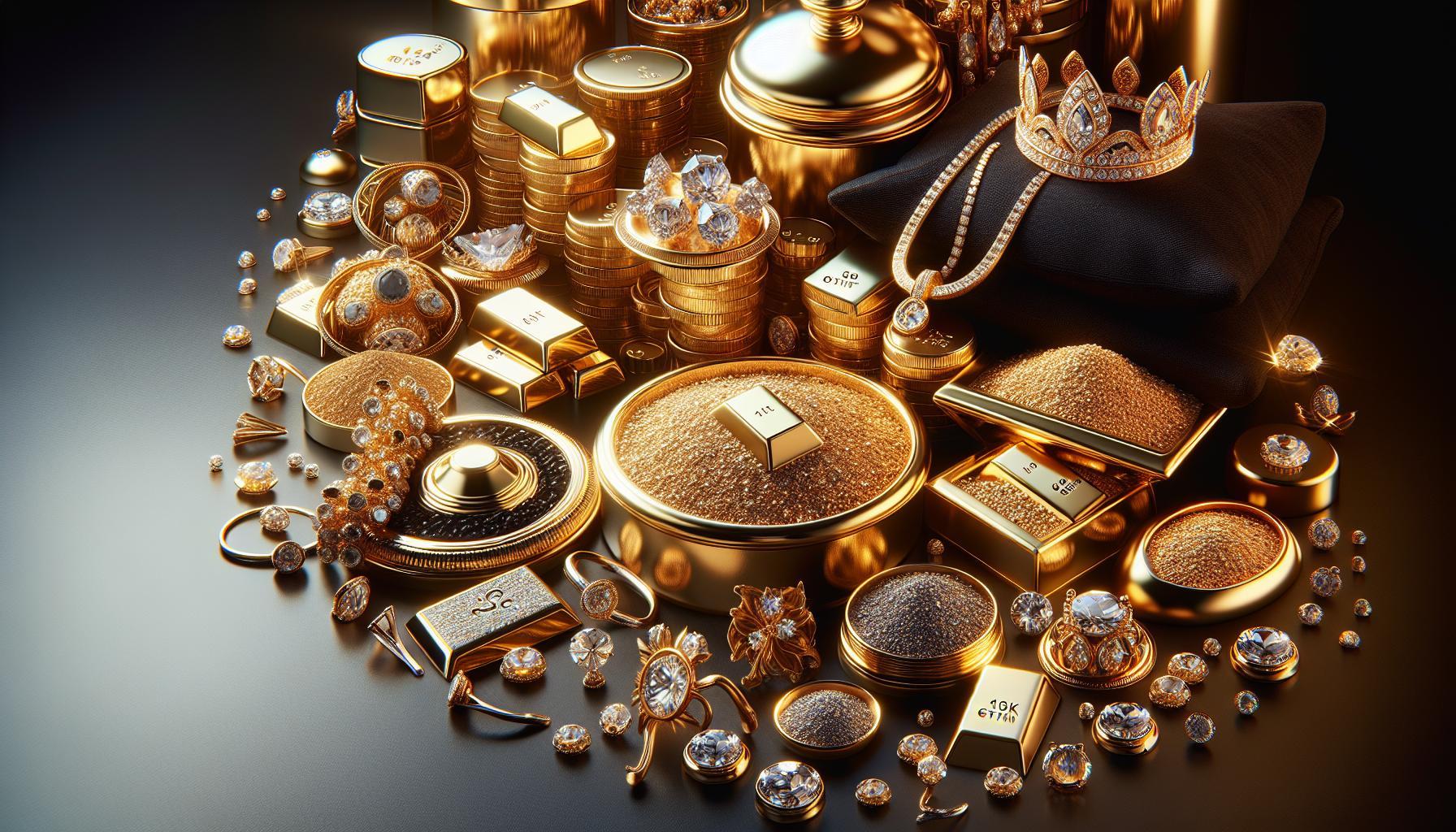in the world of jewelry, distinguishing between gold and rose gold can be surprisingly complex. Understanding their unique compositions not only informs your purchasing decisions but also enhances your appreciation of these precious metals.Dive into the essential differences that matter, from their alloy blends to their aesthetic appeal, and discover which one truly suits your style.
Understanding the Basics: What Is Gold and Rose gold?
Did you know that the captivating hues of gold and rose gold are not just a matter of aesthetics? These precious metals have distinct compositions that considerably affect their appeal, durability, and applications. Understanding these basics can help you make informed decisions whether you’re shopping for jewelry or investing in these valuable materials.
What Is Gold?
Gold is a naturally occurring metal renowned for its lustrous beauty and malleability. Its chemical symbol is Au, derived from the Latin word “aurum,” meaning “shining dawn.” This versatile metal is generally categorized based on its purity, expressed in karats (k), where 24k represents pure gold. Here are some key points about gold:
- Purity: The higher the karat, the more significant gold content, affecting durability and color.
- Properties: Gold is not only resistant to tarnishing but also exceptionally ductile, allowing it to be drawn into extremely thin wires.
- Uses: While primarily used in jewelry, gold also finds applications in electronics, dentistry, and as an investment vehicle (bullion, coins).
What Is Rose Gold?
Rose gold,often dubbed “pink gold” or “red gold,” is an alloy formed by combining pure gold with other metals,typically copper. The addition of copper is responsible for its warm, rosy hue, which has gained significant popularity in contemporary jewelry and fashion. Its color can range from a light pink to a deeper reddish tone, depending on the ratio of gold to copper. Here’s a closer look at rose gold:
- Composition: Common ratios for rose gold include 18k (75% gold and 25% copper) and 14k (58.3% gold and 41.7% copper).
- Durability: the copper content makes rose gold more durable than pure gold, making it suitable for everyday wear.
- Popularity: Rose gold has a romantic allure,making it a favored choice for engagement rings and wedding bands.
Comparative table of gold and Rose Gold
To illustrate the differences in composition and characteristics, the following table summarizes the key elements of gold versus rose gold:
| Characteristic | Gold | Rose Gold |
|---|---|---|
| Composition | Pure gold (24k) | Gold alloy with copper |
| Karat Options | 24k, 22k, 18k, etc. | 18k, 14k, etc. |
| Color | Yellow | Rose or pink |
| Durability | Soft and malleable | More durable due to copper |
Arming yourself with this knowledge about the composition differences in gold and rose gold will better equip you to navigate choices in jewelry, investments, or crafts. Whether you prefer the classic elegance of yellow gold or the romantic allure of rose gold, understanding these essential aspects will enhance your appreciation and decision-making process.
The Composition Breakdown: What Makes Gold and Rose Gold Different?
When comparing the allure of gold and the charming hue of rose gold,understanding the subtle yet significant differences in their compositions becomes essential. Both metals have rich histories and a timeless presence in jewelry, but their unique properties stem from their distinct elemental makeups.
### The Basics of Gold Composition
At its core,gold is a precious metal that has been treasured throughout history for its rarity and beauty. Pure gold is denoted as 24 karats, which means that it contains 99.9% gold content.However, this pureness makes it soft and malleable, making it less suitable for everyday wear in jewelry. To enhance its durability and resistance to scratches, gold is often alloyed with other metals. Common alloys include:
- Silver: Adds to the luster and increases malleability.
- Copper: Increases strength and gives a reddish tint, crucial for producing rose gold.
- Nickel: Often used in white gold to give it a silver-like appearance.
The percentage of gold in the alloy determines its karat classification, with 18 karat gold being 75% gold and 25% other metals.
### The Alluring Composition of Rose Gold
Rose gold, conversely, is a lovely alloy that gains its unique blush shade primarily from copper. Typically, rose gold is also measured in karats, with popular varieties being 14k (58.3% gold) or 18k (75% gold). The proportion of copper drastically influences the final color, resulting in various shades of rose gold, ranging from soft pink to deeper reddish tones.
| karat | Gold Content (%) | Copper Content (%) | Color |
|---|---|---|---|
| 14k | 58.3 | 41.7 | Light Rose |
| 18k | 75.0 | 25.0 | Deep Rose |
while both gold and rose gold start with the same precious foundation, the addition of different alloys dramatically alters not just their appearance, but also their applications and care requirements. This vital understanding lays the groundwork for informed decisions whether you’re choosing a timeless piece for daily wear or a special occasion item.
The Allure of Color: How Gold and Rose Gold Shimmer and shine
The enchanting gleam of precious metals has captivated humanity for centuries, with gold and rose gold standing out as two of the most desirable choices in jewelry and design. These metals not only serve as a form of currency or investment but also add a touch of elegance and sophistication to our lives. Understanding the fundamental differences and unique qualities that define both gold and rose gold is essential for anyone looking to invest in timeless pieces that reflect their personal style.
The Golden Touch
Gold is frequently enough celebrated for its rich, yellow glow, a hue that’s synonymous with wealth and luxury. Its purity, measured in karats, determines its value and quality. The higher the karat, the purer the gold. Here are some key characteristics of gold:
- Durability: Pure gold (24 karat) is malleable,which makes it less durable. Thus, it is often alloyed with metals like copper and silver to create stronger, more wear-resistant variations.
- Versatility: Gold can be easily shaped and styled, making it a popular choice for everything from intricate jewelry to lavish décor.
- Timeless Appeal: Its classic color and shine never go out of style, making it a staple in both contemporary and vintage designs.
The Rosy Hue of Rose Gold
Rose gold has surged in popularity, particularly over the last decade, due to its romantic and warm undertones. This unique shade is achieved by alloying gold with copper, which imparts a pinkish hue. The composition of rose gold varies in color saturation depending on the ratio of gold to copper, allowing for a range of shades from a soft blush to a deeper reddish tone:
| Composition | Color Tone |
|---|---|
| 75% Gold, 25% Copper (18K) | Rich Rose |
| 58.3% Gold, 41.7% Copper (14K) | medium Rose |
| 41.7% Gold, 58.3% Copper (10K) | Pale Rose |
- Romantic Charm: The rosy tint exudes warmth and intimacy,making rose gold a popular choice for engagement rings and personal gifts.
- Fashion-forward: It complements a variety of skin tones, making it versatile for everyday wear or special occasions.
- trendy and Contemporary: Its unique color has made it a go-to option for modern designs and minimalist aesthetics.
In comparing gold and rose gold, it’s evident that each has its distinct allure that caters to different tastes and styles. Whether you lean toward the classic elegance of gold or the romantic warmth of rose gold, understanding their composition will help you make an informed decision when choosing pieces that enhance your collection. Embracing the charm of these metals can transform not just your jewelry box but also the way you express your individuality through adornment.
Common Alloys in Jewelry: What’s Behind the Gold and Rose Gold Fades?
Gold and rose gold, cherished for their beauty and allure, often shy away from being discussed in terms of their underlying composition. Yet, understanding the alloys that comprise these metals can significantly influence both their appearance and durability. Many jewelers mix pure gold with various metals to create desirable colors and enhance the metal’s properties. Let’s dive into the common alloys found in jewelry, particularly those contributing to the rich hues of gold and rose gold.
Understanding Gold Alloys
Pure gold is 24-karat and has a lustrous yellow color, but it is too soft for everyday wear, prompting jewelers to create alloys. these combinations not only improve the metal’s strength and durability but also affect its color. Here are some of the most common alloys used in yellow gold:
- Silver: A common alloy in yellow gold, it provides a lighter tone and enhances ductility.
- Copper: Adds a rich warmth to the gold and increases hardness, making it ideal for jewelry.
- Palladium: Frequently enough paired with higher-purity gold for a more durable, tarnish-resistant finish.
- Nickel: Provides strength, though it can cause allergic reactions in some people.
The composition of these alloys greatly influences the shade and durability of the final product. understanding the specific mix can help buyers choose their jewelry more wisely, especially if they are concerned about skin reactions or the longevity of the piece.
The Alloys Behind Rose Gold
Rose gold, known for its romantic blush hue, gets its unique tone primarily from the copper content in the alloy. The degree of copper added determines the vibrancy of the pink shade. Typically, the composition can be as follows:
| Type of Gold | Gold Content (%) | Copper Content (%) |
|---|---|---|
| Rose Gold (10K) | 41.7% | 58.3% |
| Rose Gold (14K) | 58.3% | 41.7% |
| Rose Gold (18K) | 75% | 25% |
The higher the copper content, the deeper and redder the rose gold becomes. However, this also means that it may be more prone to tarnishing over time compared to yellow gold due to the nature of copper. Caring for rose gold jewelry typically involves regular polishing and occasional professional cleaning to maintain its sheen and color.
Understanding the alloys used in both gold and rose gold jewelry can help you make informed choices. Whether you prefer the classic elegance of yellow gold or the modern romance of rose gold, being knowledgeable about their compositions will guide you toward pieces that best suit your style and needs.
The Price Factor: Evaluating the Value of Gold vs. Rose Gold
Understanding the financial implications of choosing between gold and rose gold is essential for anyone considering a jewelry purchase or investment. While both options have their unique allure, the price point can significantly influence your decision. Typically, the valuation of gold and rose gold hinges on their composition and market demand, making it crucial to evaluate what each brings to the table.
When exploring the price differences, one important aspect to consider is the composition of each metal. Gold, particularly in its purest form, is frequently enough more valuable than rose gold due to its rarity and intrinsic properties.Gold is usually measured in karats (with 24-karat being pure gold), whereas rose gold is an alloy, typically made of 18-karat yellow gold combined with copper and sometimes silver. This mixture not only imparts the sought-after pink hue but can also affect the pricing structure. Below is a simplified comparison of these components and their potential pricing.
| Metal Type | Composition | Typical Price per Gram |
|---|---|---|
| gold | 24K (pure), 18K (75% gold) | varies based on market fluctuations |
| Rose Gold | 18K (75% gold + copper/silver) | Typically lower than pure gold |
With this in mind, buyers should assess their priorities when choosing between the two. For instance, while rose gold can be a more affordable alternative to pure gold, its value can remain stable due to its growing popularity, especially among younger demographics. The unique shade attracts fashion-forward individuals,often leading to higher demand. Furthermore,it’s worth noting that the copper content in rose gold can lend a distinctive character and durability that some might find appealing,possibly justifying a purchase despite the lower gold content.
Ultimately, evaluating the value of gold versus rose gold requires not only an understanding of their composition differences but also insight into your personal taste and financial flexibility. Consider investing in pieces that resonate with your style while keeping an eye on market trends; this approach not only leads to personal satisfaction but can also protect the value of your investment over time.
Durability and Care: which Metal Stands the Test of Time?
When it comes to choosing jewelry or accessories that can endure the tests of time, understanding the durability of different metals is crucial. Gold and rose gold,both celebrated for their aesthetic value,offer distinct characteristics due to their composition that affect not only their beauty but also their longevity and maintenance.
Understanding the Composition
Gold is a precious metal known for its malleability and resistance to tarnish.Pure gold, designated as 24 karats, is relatively soft. To enhance its durability, gold is often alloyed with other metals, leading to various karat ratings. Rose gold, composed of gold and copper, exhibits a beautiful pink hue. The addition of copper not only alters the color but also contributes to the metal’s strength.
- Gold is typically alloyed with metals like silver, palladium, or nickel, resulting in different karat values:
- 18K gold contains 75% gold and 25% other metals.
- 14K gold has 58.3% gold content.
Durability Comparison
Both gold and rose gold possess unique strengths and weaknesses.Gold, especially in higher karat forms (like 18K or 22K), can be more susceptible to scratching due to its softness. However, lower karats such as 10K or 14K offer better durability, making them a practical choice for daily wear. Conversely, rose gold is often favored for its strength due to the copper content, which makes it harder than yellow gold.
| Metal Type | Karats | Durability | Tarnish Resistance |
|---|---|---|---|
| Gold | 24K, 18K, 14K | Low (24K), Moderate (18K), High (14K) | High |
| Rose Gold | 18K, 14K | High (due to copper) | Moderate |
care Tips for Longevity
To maintain the beauty and integrity of these metals, proper care is essential. here are practical steps to prolong the life of your gold and rose gold jewelry:
- Regular Cleaning: Use a soft cloth to wipe down your jewelry after wearing it, removing oils and dirt that can lead to tarnishing.
- Avoid Harsh chemicals: Exposure to cleaning agents or chlorine can damage the metal finish. Always remove jewelry before any household tasks.
- Storage: Keep pieces in separate compartments to prevent scratching and tangling. A soft pouch or lined jewelry box is ideal.
- Professional maintenance: Consider periodic professional cleaning and inspection to keep your jewelry in pristine condition.
understanding the composition differences between gold and rose gold not only influences aesthetic choices but also plays a significant role in how well each metal stands up to wear over time. With proper awareness and care techniques, you can ensure that your treasured pieces remain beautiful and intact for years to come.
Style and Fashion: Choosing between Gold and Rose Gold jewelry
When contemplating an addition to your jewelry collection, the choice between gold and rose gold can be a delightful yet daunting task. Both options boast rich histories and captivating aesthetics, but their composition differences set them apart in both look and feel. Understanding these nuances is crucial for making an informed decision that reflects your personal style.
Understanding the Basics
Gold is often celebrated for its timeless elegance and classic appeal. The traditional yellow hue symbolizes wealth and luxury, making it a popular choice for both everyday wear and special occasions. In contrast, rose gold has surged in popularity in recent years, drawing attention with its warm, pinkish tones. This distinctive coloration comes from the alloying of pure gold with copper and a bit of silver. To illustrate the differences at a glance,consider the following table:
| Type of Gold | Composition | Color | Durability |
|---|---|---|---|
| Gold | Pure Gold (24K) or alloys like 14K (58.3% gold) | Radiant yellow | Moderately Durable |
| Rose Gold | Alloy of gold and copper (typically 14K or 18K) | Warm pink hue | More Durable due to higher copper content |
Choosing based on Style
Your choice between these two luxurious metals should reflect your individual style and how each complements your wardrobe. Gold tends to pair beautifully with classic and formal attire,enhancing traditional looks while radiating sophistication. As an example, a vintage-inspired gold necklace can elevate an evening gown, ensuring you stand out on a special occasion.
On the other hand, rose gold exudes a romantic and whimsical quality, making it a favorite among those who gravitate toward modern and feminine designs. Its warm tones often enhance earthy color palettes, making it a superb choice for casual outfits or bohemian-inspired ensembles. Imagine wearing a delicate rose gold bracelet stacked with other bracelets – the trend is both chic and effortlessly stylish.
Making the Final Decision
Ultimately, the decision should stem from both personal taste and practical factors. Consider the following:
- Skin Tone: rose gold tends to complement warm skin tones, while yellow gold can look stunning on both warm and cool skin tones.
- Occasion: If you’re looking for something timeless and elegant for formal events, classic gold might be the way to go, whereas rose gold is perfect for more casual or contemporary settings.
- Allergen Sensitivity: Rose gold’s copper content can cause allergic reactions in some individuals,so if you have sensitive skin,it’s worth considering your options.
By weighing these factors alongside the intrinsic composition differences outlined in the discussion of gold vs. rose gold, you can confidently select a piece of jewelry that not only complements your unique style but also suits your lifestyle and needs.
Historical Significance: The Cultural Journey of gold and Rose Gold
The allure of gold and its softer counterpart, rose gold, is a tale woven through the annals of history, reflecting cultural significance and aesthetic evolution across generations. From ancient civilizations to modern-day craftsmanship, these precious metals have not only served as symbols of wealth and status but have also informed cultural identities and artistic expression.
The Dual Legacy of Gold
Gold has been revered since antiquity for its rarity and innate beauty. It has adorned the crowns of rulers and the temples of gods, signifying divine favor and regal authority. Ancient Egyptians, for instance, meticulously crafted gold artifacts for burial rites, believing that gold would enable the departed to transcend into the afterlife. Its enduring appeal continued with the Romans who used gold to showcase their conquest and affluence. This physical and cultural journey of gold illustrates its role not merely as currency but as a powerful cultural symbol that transcends mere function.
The rise of Rose Gold
In contrast, rose gold has a more nuanced history, blossoming primarily during the 19th century with the rise of the Russian aristocracy. It became recognized as “Russian gold” due to its pinkish hue, a result of mixing yellow gold with copper. this unique coloration captivated the elite and was further popularized by jeweler Cartier in the early 1900s, creating a trend that intertwined romance and luxury. Rose gold’s warm tone evokes sentiments of affection, making it a beloved choice for engagement rings and other meaningful jewelry. Today, its vintage appeal remains strong, frequently enough symbolizing both modernity and nostalgia, a fusion that resonates deeply with contemporary consumers seeking to express individuality.
- Gold: A symbol of wealth, power, and divinity throughout history.
- Rose Gold: A romantic alternative born from the blending of yellow gold and copper.
- Cultural impact: Regarded as fashionable and represents personal narration in jewelry making.
Modern Interpretation and Trends
The modern appreciation for gold and rose gold reflects a cultural evolution that takes into account personal stories and choices. Today, consumers are not merely purchasing jewelry; they are investing in pieces that resonate personally. The choice between gold and rose gold frequently enough reflects individual tastes,as each has distinctive qualities that suit various styles and occasions. For instance, yellow gold resonates with traditional elegance, while rose gold offers a contemporary and romantic twist, appealing to those who wish to convey a softer, more intimate aesthetic.
In the realm of body adornment, understanding the composition differences in gold alloys can greatly influence purchasing decisions.The appeal of gold versus rose gold lies not only in their visual attributes but also in their historical lineage and cultural narratives. Knowledge of their significance can guide one’s choice in jewelry, transforming a simple purchase into a meaningful statement of identity and heritage. Embracing these precious metals, both in fine jewelry and everyday accessories, can forge connections to a rich tapestry of history while celebrating individual expression in a modern context.
Making the Right choice: Tips for Investing in Gold or Rose Gold Pieces
When it comes to choosing between gold and rose gold jewelry, many people are caught in a whirlwind of emotions and aesthetics. Gold has long been revered for its classic elegance, while rose gold offers a modern twist with its romantic blush tone. With this in mind, making an informed decision requires more than just a visual appeal; it’s essential to consider the composition differences that matter, durability, and how well each metal complements your style. Here are some tips to help you make the right choice.
Understanding Composition Differences
Before diving into your purchase, it’s vital to grasp the composition differences between gold and rose gold. Gold, typically found in 14K or 18K options, consists of pure gold combined with other metals to enhance strength and durability. In contrast, rose gold is an alloy of gold and copper, which gives it that distinctive rosy hue. Here are key factors to consider:
- Purity Levels: Consider whether you prefer the softness of 18K gold for its vibrant color or the sturdiness of 14K options that are more resistant to wear.
- allergy Considerations: If you have sensitive skin, opt for higher karats as they contain more pure gold, resulting in lesser allergens.
- Color Preference: Evaluate which metal complements your skin tone better; rose gold pairs beautifully with warmer tones,while classic gold shines on cooler complexions.
Evaluate Style and Versatility
Your investment should also reflect both your personal style and versatility. While gold is often seen as timeless and suitable for formal occasions,rose gold injects a fresh,contemporary vibe into everyday outfits.
- classic Pieces: If you’re looking for investment pieces like a statement necklace or a pair of earrings that never go out of style, classic gold is a reliable choice.
- Trendy Additions: For fun, fashion-forward styles that can transition from day to night, consider rose gold items that can easily pair with both casual and upscale attire.
- Layering Potential: Assess how well each choice can complement your existing jewelry collection. Mixing rose gold with other metals can create an eclectic look, while gold maintains a cohesive classic aesthetic.
| gold | rose Gold |
|---|---|
| Classic and timeless | Trendy and modern |
| Higher resistance to oxidation | Soft and romantic hue from copper alloy |
| Ideal for investment pieces | Perfect for fashion-forward styles |
Emphasizing these core factors,you’ll be better equipped to let your preferences and lifestyle guide your investment in either gold or rose gold jewelry. Whether you lean towards the everlasting luster of classic gold or the chic allure of rose gold, your choice should speak to who you are and how you wish to present yourself to the world.
FAQ
What Is Gold Vs Rose Gold? Composition Differences That Matter?
Gold is a yellow precious metal, while rose gold is a gold alloy made with copper, giving it a unique pink hue. Understanding the composition differences is essential for selecting the right type for jewelry or investment.
both metals contain gold, but the proportions vary. Pure gold is 24 karats,whereas rose gold typically has a lower karat count,such as 18 or 14,indicating the amount of gold content compared to the copper and other metals added. The higher the copper content in rose gold, the more pronounced the pink tint.
If you’re interested in learning more about the characteristics of different gold types, check out our detailed guide on gold types and their uses.
Why Does the Composition Matter in Gold Versus Rose gold?
The composition of gold versus rose gold affects both the appearance and durability of the metals. Gold is known for its lustrous yellow color, while rose gold provides a warm, vintage appeal.
Higher copper content in rose gold not only influences its color but also increases its hardness, making it more resistant to scratches. This can be favorable for jewelry that receives daily wear, such as rings or bracelets. On the other hand,pure gold (24k) is softer and requires more care to maintain its appearance.
Choosing the right metal is crucial based on your lifestyle and aesthetic preferences. consider visiting our page on gold care tips for better maintenance insights.
Can I Get Allergies from Gold and Rose Gold?
yes, it is possible to have allergic reactions to gold and rose gold, particularly due to the metals used in their composition.Some individuals may be sensitive to the copper or nickel utilized in lower karat golds.
For those with metal allergies, opting for higher karat gold (such as 18k or 22k) or pure gold can reduce the risk of irritation. rose gold’s copper content may also cause reactions in sensitive individuals, so it is advisable to know your metal sensitivities when investing in jewelry.
For more information on hypoallergenic options,you might find our resource on hypoallergenic jewelry helpful.
How Does the Price Compare Between Gold and Rose gold?
Generally, the price of gold is higher than that of rose gold due to the proportion of pure gold in each piece. The more gold content, the higher the price per gram.
Rose gold, often being mixed with other metals like copper, tends to be less expensive. Though, market prices can vary widely based on design, craftsmanship, brand, and current gold market trends. Thus, it is indeed crucial to compare different pieces to find the best value.
Understanding market conditions is essential; check out our analysis on gold market trends for pricing insights.
What Are the Aesthetic Differences Between Gold and Rose Gold?
The main aesthetic difference between gold and rose gold is in their color. Gold has a classic yellow hue, while rose gold is noted for its pinkish tones, which can add a vintage or romantic flavour.
This color difference plays a significant role in fashion and design.While gold may be perceived as more traditional, rose gold has become fashionable in recent years, appealing to a variety of styles, from modern to antique.
For more insights into choosing the right color for your jewelry, visit our article on jewelry color preferences.
Is Rose Gold More Durable Than Gold?
Yes, due to its composition, rose gold is generally considered more durable than pure gold. The addition of copper enhances its hardness, making it more resistant to scratching and bending.
While pure gold is soft and malleable, rose gold’s blend of metals makes it a popular choice for everyday wear. This characteristic is especially critically important for items like engagement rings, which require durability to withstand daily use.
learn more about jewelry durability and maintenance techniques in our section on jewelry durability.
What Should I Choose for Jewelry: Gold or Rose gold?
The choice between gold and rose gold for jewelry largely depends on personal preference and skin tone. Gold is classic and elegant, while rose gold offers a trendy, romantic aesthetic.
If you prefer a more traditional look or are purchasing investment pieces, yellow gold might be the way to go. Conversely, if you want something modern and unique, rose gold can provide that distinctive flair.
Evaluate your personal style and consider factors like your wardrobe and skin tone to make the best decision. For more style tips, check out our guide on choosing the right jewelry.
In Conclusion
understanding the intricacies of gold and rose gold is essential for both prospective investors and jewelry lovers alike. Gold’s timeless allure is rooted in its unparalleled quality and intrinsic value, while rose gold’s unique warm hues offer a modern twist that appeals to contemporary tastes. By delving into their composition differences—ranging from gold’s purity measured in karats to rose gold’s added copper content—one can make informed decisions that resonate with both financial acumen and personal style.
As you explore these precious metals further,consider how their historical significance and cultural symbolism enhance their appeal. Whether you’re looking to invest or simply seeking the perfect piece of jewelry, embracing the nuances of gold and rose gold will undoubtedly enrich your experience. We invite you to engage with our additional resources and articles, providing insights that support your journey into the interesting world of precious metals. Your exploration starts here—let the journey into gold continue!






